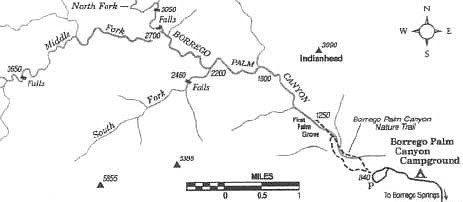 Facebook
Facebook
 X
X
 Instagram
Instagram
 TikTok
TikTok
 Youtube
Youtube
The remote and rugged upper reach of Anza-Borrego's most famous "palm canyon," Borrego Palm Canyon, has suddenly become much easier to explore. Last summer's mammoth Pines Fire, which originated near Julian, swept many miles north and northeast, eventually consuming thousands of acres of mature chaparral and high-desert vegetation on the desert face of the San Ysidro Mountains -- including much of Borrego Palm Canyon.
For any exploration of the canyon, short or long, you can begin at the Borrego Palm Canyon parking lot on the west edge of Borrego Palm Canyon Campground. Follow the main, popular trail up a broad alluvial fan toward the narrow mouth of the canyon, where the "first grove" of palms comes into view up ahead. In the coming month you should enjoy the best display of spring wildflowers hereabouts in years.
At 1.5 miles, in the narrows of the canyon, you reach the end of the nature trail and fences that discourage further travel. To go farther, take a side path on the right, leading to a viewpoint overlooking the grove, and proceed up the canyon by hopping over boulders. Hikers have "voted with their feet" in the next mile or so, wearing in an intermittent, sometimes circuitous trail alongside or near the currently lively stream in the canyon bottom.
Before long, you reach the edge of the burn zone, where the combination of dense riparian and desert scrub vegetation has been incinerated, allowing relatively easy passage for now and perhaps during the next year or two. The scattered groups of palms you'll encounter in the miles ahead have, as a whole, shrugged off the effects of the fire, their blackened trunks readily sprouting fresh green fronds. Wherever water has been flowing, greenery is rapidly returning. With continuing rain showers, a spectacular display of fire-following wildflowers may occur here by late March or early April.
At 3.3 miles from the start, Borrego Palm Canyon's South Fork branches obviously to the left (southwest), away from the main Middle Fork. Follow this canyon 0.4 mile to discover a thin but beautifully cascading waterfall -- assuming rain this season continues to fall at average or better rates.
Since the fire, a number of hikers have succeeded in traveling the entire 10-mile stretch of the Middle Fork leading into the Los Coyotes Indian Reservation. They have reported this journey as much easier than before, but certainly no leisurely amble!
Whatever your goal is, be advised that any travel beyond the first 1.5 miles requires sturdy footwear and the ability to negotiate potentially ankle-busting terrain. As the springtime weather warms in late March and April, don't underestimate your need for potable water.


The remote and rugged upper reach of Anza-Borrego's most famous "palm canyon," Borrego Palm Canyon, has suddenly become much easier to explore. Last summer's mammoth Pines Fire, which originated near Julian, swept many miles north and northeast, eventually consuming thousands of acres of mature chaparral and high-desert vegetation on the desert face of the San Ysidro Mountains -- including much of Borrego Palm Canyon.
For any exploration of the canyon, short or long, you can begin at the Borrego Palm Canyon parking lot on the west edge of Borrego Palm Canyon Campground. Follow the main, popular trail up a broad alluvial fan toward the narrow mouth of the canyon, where the "first grove" of palms comes into view up ahead. In the coming month you should enjoy the best display of spring wildflowers hereabouts in years.
At 1.5 miles, in the narrows of the canyon, you reach the end of the nature trail and fences that discourage further travel. To go farther, take a side path on the right, leading to a viewpoint overlooking the grove, and proceed up the canyon by hopping over boulders. Hikers have "voted with their feet" in the next mile or so, wearing in an intermittent, sometimes circuitous trail alongside or near the currently lively stream in the canyon bottom.
Before long, you reach the edge of the burn zone, where the combination of dense riparian and desert scrub vegetation has been incinerated, allowing relatively easy passage for now and perhaps during the next year or two. The scattered groups of palms you'll encounter in the miles ahead have, as a whole, shrugged off the effects of the fire, their blackened trunks readily sprouting fresh green fronds. Wherever water has been flowing, greenery is rapidly returning. With continuing rain showers, a spectacular display of fire-following wildflowers may occur here by late March or early April.
At 3.3 miles from the start, Borrego Palm Canyon's South Fork branches obviously to the left (southwest), away from the main Middle Fork. Follow this canyon 0.4 mile to discover a thin but beautifully cascading waterfall -- assuming rain this season continues to fall at average or better rates.
Since the fire, a number of hikers have succeeded in traveling the entire 10-mile stretch of the Middle Fork leading into the Los Coyotes Indian Reservation. They have reported this journey as much easier than before, but certainly no leisurely amble!
Whatever your goal is, be advised that any travel beyond the first 1.5 miles requires sturdy footwear and the ability to negotiate potentially ankle-busting terrain. As the springtime weather warms in late March and April, don't underestimate your need for potable water.
